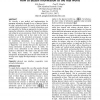Free Online Productivity Tools
i2Speak
i2Symbol
i2OCR
iTex2Img
iWeb2Print
iWeb2Shot
i2Type
iPdf2Split
iPdf2Merge
i2Bopomofo
i2Arabic
i2Style
i2Image
i2PDF
iLatex2Rtf
Sci2ools
UIST
1998
ACM
1998
ACM
Informative Things: How to Attach Information to the Real World
We describe a new method and implementation for managing information through the use of physical objects. In today’s networked world, the trend is toward working in a global virtual environment. To transfer information, users are responsible for finding an appropriate storage location, naming the information, selecting the transport mechanism, and setting the access permissions. Much of the time, these burdens are needless and, in fact, stand in the way of productive use of the networked environment. In many circumstances, a physical floppy disk is the ideal medium for transferring information, as it eliminates these complications. Our Informative Things approach provides a “floppy-like” user interface that gives the impression of storing information on physical objects. In reality, our system stores information in the network, associating pointers to information with objects in the physical world. By hiding these details, we simplify information management. By linking the physi...
Physical Floppy Disk | Physical Objects | Software Engineering | Today’s Networked World | UIST 1998 |
| Added | 05 Aug 2010 |
| Updated | 05 Aug 2010 |
| Type | Conference |
| Year | 1998 |
| Where | UIST |
| Authors | Rob Barrett, Paul P. Maglio |
Comments (0)

